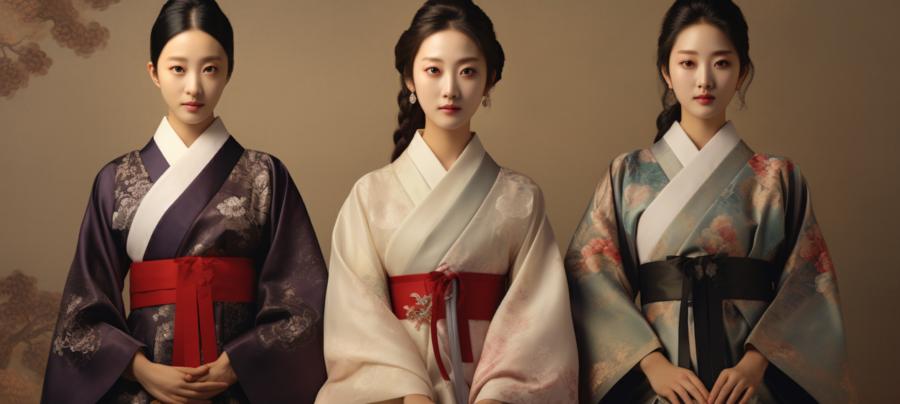Hanbok Elegance: Joseon Dynasty Korea's Traditional Dress

Frolicking in Fashion: A Journey Back in Time
Imagine, if you will, a time when mobile phones were as foreign as the idea of interstellar travel. A time when the elegance of a person's attire spoke volumes about their social standing and character. This, my friends, is the world of the Joseon Dynasty, a bygone era that spanned five centuries of Korean history, a veritable playground of sartorial splendor!Welcome to the realm of the Hanbok, a traditional Korean dress that demands respect and admiration from all who behold its graceful lines and vibrant colors. It's as if the wearer has been dressed by the very gods themselves, with every fold and pleat an exquisite testament to the artisan's skill. Join me, won't you, as we take a wild ride through the sumptuous world of Hanbok elegance!
Where Silk Meets Skin: The Components of Hanbok
Before we delve into the intricacies of the Hanbok's design, let us first acquaint ourselves with its basic components. A Hanbok consists of two main parts: the jeogori, a short jacket with long sleeves, and the chima, a full, high-waisted skirt for women, or baji, loose-fitting pants for men.The jeogori sits snugly against the upper body, its tight-fitting armholes and sleeves creating a sense of balance with the billowing chima or baji. This delicate dance of proportion is a key characteristic of the Hanbok, and the epitome of its elegance.
Color Me Beautiful: The Symbolism of Hanbok Colors
In the world of the Hanbok, the choice of color is far from arbitrary. Each hue carries with it a deep, symbolic meaning that transcends mere aesthetics. The five primary colors of the Hanbok are blue, red, yellow, white, and black, representing the five elements of the ancient Korean yin and yang philosophy: wood, fire, earth, metal, and water, respectively.These colors are often combined in a single garment to create a harmonious balance of energy, as well as to signify the wearer's social status. For instance, during the Joseon Dynasty, yellow was reserved for the royal family, while commoners were restricted to less ostentatious colors such as white, gray, and pale pink.
A Stitch in Time: The Artistry of Hanbok Embroidery
A true Hanbok is a work of art, with intricate embroidery adorning its surface. This was no mere frivolous decoration, but rather an expression of the wearer's beliefs, aspirations, and social standing. It was not uncommon for a Hanbok to feature embroidered symbols of longevity, such as cranes and turtles, as well as auspicious plants like peonies and chrysanthemums.The level of detail in the embroidery also served as an indicator of the wearer's social rank. The higher one's status, the more ornate and elaborate the embroidery on their Hanbok would be. This was a world where every stitch told a story, and your clothes truly made the man (or woman).
The Grace of the Geumbak: Gilding the Hanbok Lining
As if the exquisite embroidery wasn't enough, some Hanbok garments were further embellished with a touch of gold. This technique, known as geumbak, involved carefully applying a thin layer of gold leaf to the surface of the fabric, creating a shimmering, ethereal effect that enhances the natural beauty of the silk.Geumbak was typically reserved for the most luxurious Hanbok garments, those worn by the upper echelons of society. It was a dazzling display of wealth and taste, a subtle reminder to those who beheld it that they were in the presence of greatness.
Hanbok Today: A Timeless Treasure
While the days of the Joseon Dynasty have long since passed, the Hanbok remains a beloved symbol of Korean culture and heritage. Modern iterations of the traditional dress can be seen at cultural events, weddings, and even on the runway, as contemporary designers breathe new life into this ancient art form.For those seeking to experience the elegance of the Hanbok firsthand, fear not, for opportunities abound! One can rent a Hanbok for a day at various tourist locations in South Korea, allowing you to stroll the streets of Seoul or explore the grounds of Gyeongbokgung Palace in true Joseon Dynasty fashion.
So, dear adventurers, let us raise a toast to the enduring elegance of the Hanbok, a testament to the beauty and sophistication of a bygone era that continues to captivate the hearts and minds of people around the world. Long live the Hanbok!
Article kindly provided by foreverinfashion.org
Latest Articles
- The Psychology of Tattoo Aesthetics: Why Certain Imagery Resonates
- Style That Works With Your Body, Not Against It
- Fashion Tourism on Wheels: Curated Shopping Routes Led by Chauffeur Guides
- The Charm of Certainty in a World of Indecision
- Can an Everyday T-Shirt Be Turned into a Modern Heirloom?
- Color, Ceremony, and the Psychology of Celebration
- Styling Graphic T-Shirts for Different Body Types
- Getting Kids to Wear Their Hats Without a Bribe or a Meltdown
- Mastering the Art of Being the Unnoticed Photographer
- Quiet Sportswear Moves Loudly
- Fashion's Most Misunderstood Color Is Brown
- Weight Matters When Cotton Gets Real
- SKU's Out for Summer: Why Your Warehouse Is Melting Down
- Ink as Accessory - How Tattoos Are Replacing Jewelry in Modern Style
- Accessories
- Jewellery
- Footwear
- Skirts and Dresses
- Shirts and Blouses
- Beauty and Makeup
- Fashion Photography
- Sustainable Fashion
- Street Style
- Fashion History
- Fashion Business
- Fashion Styling
- Fashion Events
- Plus-Size Fashion
- Men's Fashion
- Women's Fashion
- Fashion Blogging
- Fashion Trends
- Fashion Retailers
- Fashion Tips and Advice
- Fashion Business Startups
- Fashion Around the World
- Lingerie
- Sportswear
- Weddings

